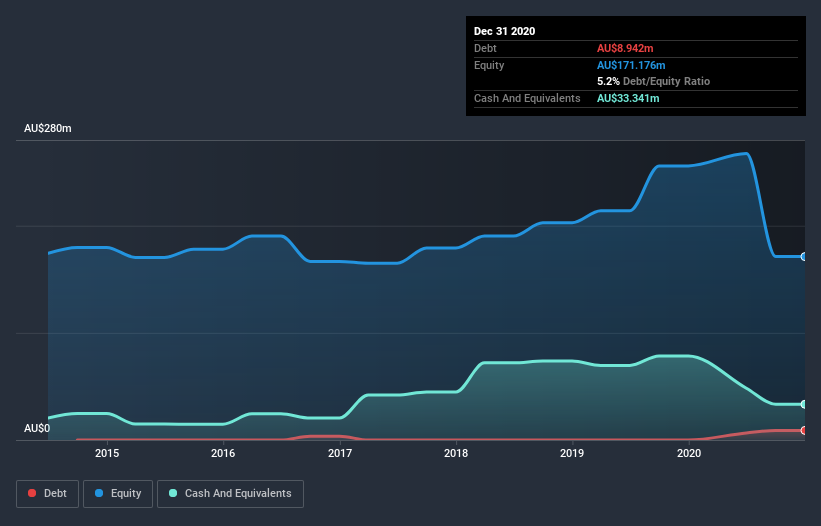Does Alkane Resources (ASX:ALK) Have A Healthy Balance Sheet?
The external fund manager backed by Berkshire Hathaway's Charlie Munger, Li Lu, makes no bones about it when he says 'The biggest investment risk is not the volatility of prices, but whether you will suffer a permanent loss of capital.' So it might be obvious that you need to consider debt, when you think about how risky any given stock is, because too much debt can sink a company. We can see that Alkane Resources Limited (ASX:ALK) does use debt in its business. But the real question is whether this debt is making the company risky.
When Is Debt Dangerous?
Debt is a tool to help businesses grow, but if a business is incapable of paying off its lenders, then it exists at their mercy. In the worst case scenario, a company can go bankrupt if it cannot pay its creditors. However, a more frequent (but still costly) occurrence is where a company must issue shares at bargain-basement prices, permanently diluting shareholders, just to shore up its balance sheet. Of course, the upside of debt is that it often represents cheap capital, especially when it replaces dilution in a company with the ability to reinvest at high rates of return. The first step when considering a company's debt levels is to consider its cash and debt together.
Check out our latest analysis for Alkane Resources
What Is Alkane Resources's Net Debt?
You can click the graphic below for the historical numbers, but it shows that as of December 2020 Alkane Resources had AU$8.94m of debt, an increase on none, over one year. However, its balance sheet shows it holds AU$33.3m in cash, so it actually has AU$24.4m net cash.
How Healthy Is Alkane Resources' Balance Sheet?
Zooming in on the latest balance sheet data, we can see that Alkane Resources had liabilities of AU$18.5m due within 12 months and liabilities of AU$20.2m due beyond that. Offsetting this, it had AU$33.3m in cash and AU$3.15m in receivables that were due within 12 months. So its liabilities outweigh the sum of its cash and (near-term) receivables by AU$2.15m.
This state of affairs indicates that Alkane Resources' balance sheet looks quite solid, as its total liabilities are just about equal to its liquid assets. So while it's hard to imagine that the AU$410.8m company is struggling for cash, we still think it's worth monitoring its balance sheet. While it does have liabilities worth noting, Alkane Resources also has more cash than debt, so we're pretty confident it can manage its debt safely.
On top of that, Alkane Resources grew its EBIT by 52% over the last twelve months, and that growth will make it easier to handle its debt. The balance sheet is clearly the area to focus on when you are analysing debt. But it is future earnings, more than anything, that will determine Alkane Resources's ability to maintain a healthy balance sheet going forward. So if you're focused on the future you can check out this free report showing analyst profit forecasts.
Finally, a business needs free cash flow to pay off debt; accounting profits just don't cut it. While Alkane Resources has net cash on its balance sheet, it's still worth taking a look at its ability to convert earnings before interest and tax (EBIT) to free cash flow, to help us understand how quickly it is building (or eroding) that cash balance. Considering the last three years, Alkane Resources actually recorded a cash outflow, overall. Debt is far more risky for companies with unreliable free cash flow, so shareholders should be hoping that the past expenditure will produce free cash flow in the future.
Summing up
While it is always sensible to look at a company's total liabilities, it is very reassuring that Alkane Resources has AU$24.4m in net cash. And it impressed us with its EBIT growth of 52% over the last year. So we don't have any problem with Alkane Resources's use of debt. When analysing debt levels, the balance sheet is the obvious place to start. But ultimately, every company can contain risks that exist outside of the balance sheet. These risks can be hard to spot. Every company has them, and we've spotted 3 warning signs for Alkane Resources (of which 1 is concerning!) you should know about.
When all is said and done, sometimes its easier to focus on companies that don't even need debt. Readers can access a list of growth stocks with zero net debt 100% free, right now.
This article by Simply Wall St is general in nature. It does not constitute a recommendation to buy or sell any stock, and does not take account of your objectives, or your financial situation. We aim to bring you long-term focused analysis driven by fundamental data. Note that our analysis may not factor in the latest price-sensitive company announcements or qualitative material. Simply Wall St has no position in any stocks mentioned.
Have feedback on this article? Concerned about the content? Get in touch with us directly. Alternatively, email editorial-team (at) simplywallst.com.

 Yahoo Finance
Yahoo Finance 
